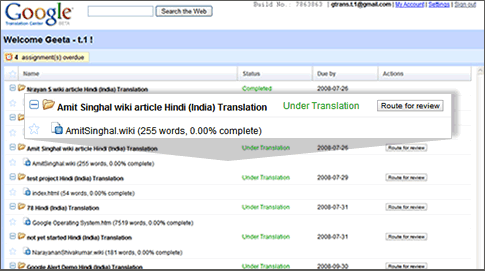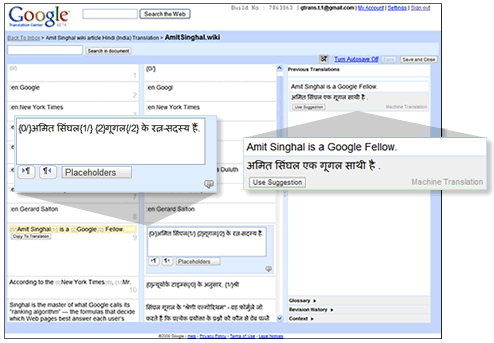Well it really sounds gr8, two Indian students among 14 all over the world is gonna participate in the NASA's annual meeting at Atlanta. A team of two students from Karunya University are among the 14 selected from all over the world by the National Aeronautics and Space Administration (NASA) to attend its annual meeting at Atlanta, the United States. The team consisting of Susheel Michael Jones and M. Vinay, third year students of the Electronics and Communication Engineering Department, participated in the student contest organised under the aegis of the Fundamental Aeronautics Programme of the A eronautics Research Mission Directorate of the NASA. They had to design an aircraft for 2058. Susheel and Vinay presented ideas for making an aircraft that will require less runway space, will be less in weight and cost but high in safety. The project included ideas as to the material that will be used, the means by which it can be made safe and protected from being attacked, etc. Though two teams – one from the U.S. and the other from Anna University, Madras – were judged winners, the other 12 teams (only two from India) have been recognised for their innovative ideas and invited to attend the meeting of the NASA for a special student session. Susheel and Vinay will visit (accompanied by their faculty adviser C. Kezi Selva Vijila) Atlanta to attend the meeting which is scheduled from October 6 to 9. Both of them have been in touch with other team members over e-mail. While Vinay wants to pursue higher studies in nanotechnology and go in for defence research, Susheel has plans to become an entrepreneur and manufacture environment-friendly products.
Well it really sounds gr8, two Indian students among 14 all over the world is gonna participate in the NASA's annual meeting at Atlanta
Google is working on a new service called Google Translation Center. Just a short while ago, we noticed that “center” had been added to Google’s robots.txt file, and now co-editor Tony Ruscoe discovered the link to the working frontpage... though logging in fails right now. According to the Google explanations on the frontpage and their product overview page, we can see this is meant to be a translation service which offers both volunteers and professional translators... and I suppose at least the professionals will want to get paid. In that regards, the service is in the field of sites like Click2Translate.com (a service by the company which Tony works for, incidentally, and which I’m often using for some of my sites).
Here’s what’s printed as a description on the service’s frontpage:
<<Request translations and find translators
Upload your document and request translations into over 40 languages. [*]
Translate and review translated documents
Create and review content in your language through Google’s free, easy-to-use, online translation tools.>>
And these are the sample screenshots Google shows off in their product introduction:

The project creation page. You can provide fields like project name (e.g. “FAQ page”), description, due date and owners. You can set the source and target language, upload a local file to be translated, and assign a translator and a reviewer. “If a translator accepts, you should receive your translated content back as soon as it’s ready,” Google says (note the “if” part, a potentially important difference to paid-only translation services).

This is what Google calls the translator inbox in their screenshot file name. It looks like the overview page for those approaching the Google Translation Center as a translator. Google says, “Passionate about bringing content into your language? Browse through Google Translation Center to find open translation requests into your language. Accept translation requests and use Google translation tools to provide quick, high-quality translations.” In this view, you can find out the number of assignments, and the completion status for each.

The part Google calls the translator workbench. In this view, the translator sees the source text and the translation in progress side-by-side. An option on top toggles auto-saving. A third column offers a couple of helper tools for the translation, like a revision history, a glossary, or a history of previous translations.
More than an all-in-one stop for paid translations as some of the competing services in this field, the Google Translation Center looks like it aims to be a marketplace coordinator and tool provider. Just how Google could make money with this is another question. Google often goes for ads; in this system, one might think getting commissions for paid jobs would be an option, but there’s a part in the terms and conditions of the service which makes me wonder if there will be such a thing – Google says (my emphasis):
<
I’m also curious if volunteers will get paid, too, as one might think it’s not like everyone is waiting to do free translations... unless they identify with a site or some content re-use is allowed (like an open source project, perhaps, or a Creative Commons licensed article). If Google decides to provide a rating system, though, then volunteering for projects may have the side-effect of increasing one’s status within the service.
Another interesting aspect is how Google will handle the service’s feature to match current translations with previous ones. Tony says, “This sounds like what the industry calls a ’Translation Memory’. Usually, the client would pay for a translation memory and own it since they paid for the translations.” Tony adds that if Google may plan to add something like a “global Translation Memory,” then this could raise the questions whether or not customers end up paying for pro translators to find their translation memory be re-used by other companies. Another issue of discussion will likely be the translation quality, by and large; just imagine someone volunteering to sneak in insults or spam. From Google’s FAQ on this:
<<Does Google provide guarantees on the quality of the services provided by Google Translation Center?
No. Translations created in Google Translation Center are purely between the translation requester and the translators.>>
And as the terms of service argue, “Google will not” be “involved in resolving any disputes between you and any third party participant(s) related or arising out of your use of Google Translation Center”. But let’s wait and see. Judging from my past translation jobs as a webmaster – give the service a data file containing all your content strings, plug it back in later on and suddenly have a multi-language website – this is definitely an interesting and highly useful field. Right now, according to the FAQ, “Google Translation Center is in limited release through Google’s Trusted Tester Program” which gives “friends and family members of Google employees a chance to test-drive our early beta, prior to release. Later, anyone can sign up to request and provide translations through Google Translation Center.”
GV. Prakash is now the most talked about, upcoming music director in Tamil Cinema.
A full-fledged music director at 19, G.V. Prakash now has big names such as Shankar Mahadevan and Alka Yagnik singing his tunes.No big deal, some may say, about this talent whose uncle is none other than A.R. Rahman. But few know that Prakash is also a Grade 8 gold medallist in solo piano from Trinity College, London. And that he has worked as a keyboard programmer with leading music composers such as Bharadwaj, Vidyasagar and Harris Jeyaraj.
A mop of unruly hair keeps falling on his face — much like the hairstyle Rahman sported earlier — and Prakash has an angelic smile to boot. He prefers to work his magic when the rest of the world sleeps. And like his talented uncle, Prakash also started by composing jingles.
"He was performing at a cultural festival in school when officials from the School of Audio Engineering invited him to join their institution," .He promptly quit Standard 11 to pursue a diploma in sound engineering.While studying at SAE, he worked on Bharadwaj's "Autograph", "Jay Jay", "Vasoolraaja MBBS" and the animated film "Buddha."
He then worked with Vidyasagar on "Kana Kandaen," "Ji" and the Telugu movie "Bangaram." He also did some jingles for HDFC, Radio Mirchi (for their first and second anniversaries) and Nokia.With Harris Jeyaraj, he worked on "Arasaktchi," "Anniyan" and "July Kaatru."
He was actually only the keyboard programmer for "Anniyan," but Shankar wanted him to sing too and that is how he ended up singing Kaadhal Yaanai."Prakash then worked on "Swades," "Kisna," "The Rising: Ballad of Mangal Pandey," "Dil Ne Jise Apna Kaha," "Rang de Basanti," "Netaji Subhas Chandra Bo se — The Forgotten Hero" and "Anbe Aaruyire" during the one-and-a-half years he was with Rahman.
"Rahman actually never knew he was a keyboard player. Only when he started working did he come to know about this. He then called him, heard his showreel and took him in immediately."
Director Vasantha Balan was also impressed with his showreel and signed him on for "Veyyil.Director Shankar's Veyyil has been declared a hit. It has not only brought fame and stardom to director Vasantha Balan and Pasupathy, but also to young music composer G V Prakash.
" While working on the film, Prakash was offered "Auto," directed by husband-wife team Pushkar and Gayatri. "Veyyil has a rural feel and the songs are set in different periods. One reflects the music of the 1970s, another of the nineties, and another is contemporary. But Auto is set a jolly, fast-paced movie set in Chennai. The music reflects the city's colours.
" He is doing the background score and a song for Sirish Kunder's debut Hindi film, "Jaan-e-Man," a Tamil-Telugu film "Roman Letter - III" directed by Milind Rao and produced by Ram Gopal Varma, and a fusion album with ace percussionist Sivamani.
GV Prakash’s music is 99.99% similar to Rahman’s style. While Rahman’s first movie Roja was a major departure from the ‘then prevailant and popular’ Illaiyaraja’s style (which is why ARR’s became big and has lasted this long), Its a wonder how big of a change/difference GV prakash’s music is from current day composers including his own uncle.
The new kid on the block is having loads of fun. "he met different people, and no person has similar ideas. They came to him with different perspectives, different situations. So all his songs have different flavours."With his father helping him handle finances, he is setting up a recording studio. "The work is almost over, and Divine Labs will be opened soon."
Roller skates would be an ideal present for G.V Prakash, who turns 21 this year. Squeezing an interview in between an exhaustive meeting with director Selvaraghavan for Aaryirathil Oruvan (in which he has replaced Yuvan Shankar Raja) and a composing session with lyricist Vairamuthu for the IPL’s Chennai Super Kings’ theme song, the young music director is on the go 24 by 7.
Prakash has composed songs for the much-awaited Kushelan. Big project indeed, composing for the Superstar at this young an age.

Fact File:
Born: June 13, 1987
Education: Chettinad Vidyashram, Chennai
Instrument: Solo Piano, Gold Medallist, Grade 8, Trinity College, London
Future projects: Leelai, Ananda Thandavam, Aayirathil Oruvan and Kushelan
First shot at fame: Sang in Chikku Bukku Railu, Gentleman when he was a kid.
At the young age of 21, Prakash has created an impact among music-lovers. Emulating his uncle is GV Prakash.
scribbles by,
johny :)














